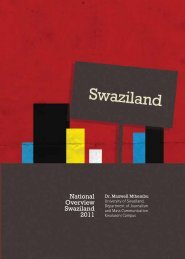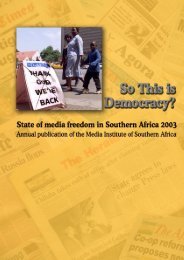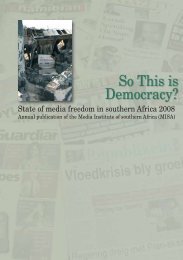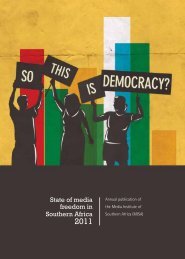Twenty years after the Windhoek Declaration on press freedom
Twenty years after the Windhoek Declaration on press freedom
Twenty years after the Windhoek Declaration on press freedom
Create successful ePaper yourself
Turn your PDF publications into a flip-book with our unique Google optimized e-Paper software.
Taking stock of gender in media<br />
educati<strong>on</strong><br />
By Emily M. Brown<br />
Emily M. Brown is Head of <str<strong>on</strong>g>the</str<strong>on</strong>g><br />
Department of Media Technology,<br />
Polytechnic of Namibia<br />
152 | Media in Africa - 2011<br />
The Gender in Media Educati<strong>on</strong><br />
(GIME) audit that kicked off in<br />
Namibia in 2010 raises pertinent<br />
issues with regard to <str<strong>on</strong>g>the</str<strong>on</strong>g> quality of<br />
our journalism. Implemented at <str<strong>on</strong>g>the</str<strong>on</strong>g><br />
outset by UNESCO, Gender Links<br />
and <str<strong>on</strong>g>the</str<strong>on</strong>g> Polytechnic of Namibia, <str<strong>on</strong>g>the</str<strong>on</strong>g><br />
audit dealt with how gender was<br />
addressed in journalism training<br />
programmes and curricula.<br />
The goals were to identify:<br />
• whe<str<strong>on</strong>g>the</str<strong>on</strong>g>r gender was integrated<br />
into media educati<strong>on</strong> and<br />
training,<br />
• whe<str<strong>on</strong>g>the</str<strong>on</strong>g>r gender-related texts<br />
or materials were used in media<br />
educati<strong>on</strong> and training, and<br />
• gaps with regard to mainstreaming<br />
gender in journalism<br />
curricula.<br />
In <str<strong>on</strong>g>the</str<strong>on</strong>g> Beijing Platform for Acti<strong>on</strong>,<br />
<str<strong>on</strong>g>the</str<strong>on</strong>g> media – as <str<strong>on</strong>g>the</str<strong>on</strong>g> 10th critical<br />
area of c<strong>on</strong>cern – have a major role<br />
to play regarding gender equality.<br />
Fur<str<strong>on</strong>g>the</str<strong>on</strong>g>rmore, <str<strong>on</strong>g>the</str<strong>on</strong>g> SADC Protocol <strong>on</strong><br />
Gender and Development prescribes<br />
that gender parity ought to prevail<br />
in media houses by 2015.<br />
Meantime, however, it is not even<br />
comm<strong>on</strong> to have discourse that disaggregates<br />
informati<strong>on</strong> <strong>on</strong> gender<br />
lines in <str<strong>on</strong>g>the</str<strong>on</strong>g> media.<br />
Yet if <str<strong>on</strong>g>the</str<strong>on</strong>g> media are to c<strong>on</strong>tinue to<br />
inform and stimulate public debate<br />
and dialogue, we need journalists<br />
who have <str<strong>on</strong>g>the</str<strong>on</strong>g> ability to provide diverse<br />
perspectives <strong>on</strong> a particular<br />
issue – and be gender-sensitive in<br />
so doing. So much is hidden when<br />
reportage is packed with collective<br />
nouns such as “<str<strong>on</strong>g>the</str<strong>on</strong>g> Sou<str<strong>on</strong>g>the</str<strong>on</strong>g>rn<br />
African Regi<strong>on</strong>”, “<str<strong>on</strong>g>the</str<strong>on</strong>g> students”,<br />
“<str<strong>on</strong>g>the</str<strong>on</strong>g> workers” or even “staff in <str<strong>on</strong>g>the</str<strong>on</strong>g><br />
newsroom”. Imagine how this could<br />
change when an engendered approach<br />
is adopted.<br />
However, according to <str<strong>on</strong>g>the</str<strong>on</strong>g> GIME<br />
Sou<str<strong>on</strong>g>the</str<strong>on</strong>g>rn Africa (2010) – which covered<br />
25 instituti<strong>on</strong>s in 13 countries<br />
– journalism / media studies students<br />
receive very little <str<strong>on</strong>g>the</str<strong>on</strong>g>oretical<br />
grounding in gender. Implicit in this<br />
finding is that few instituti<strong>on</strong>s have<br />
integrated gender into <str<strong>on</strong>g>the</str<strong>on</strong>g>ir course<br />
c<strong>on</strong>tent.<br />
“SADC Protocol<br />
<strong>on</strong> Gender and<br />
Development<br />
prescribes that gender<br />
parity ought to prevail<br />
in media houses by<br />
2015.”<br />
Ano<str<strong>on</strong>g>the</str<strong>on</strong>g>r finding of <str<strong>on</strong>g>the</str<strong>on</strong>g> 2010 audit<br />
is that even fewer instituti<strong>on</strong>s have<br />
stand-al<strong>on</strong>e gender policies.<br />
Many of <str<strong>on</strong>g>the</str<strong>on</strong>g> representatives of instituti<strong>on</strong>s<br />
surveyed could <strong>on</strong>ly make<br />
reference to broader affirmative acti<strong>on</strong><br />
policies and procedures, or to<br />
<str<strong>on</strong>g>the</str<strong>on</strong>g>ir country’s nati<strong>on</strong>al gender policy,<br />
in regard to vehicles for providing<br />
instituti<strong>on</strong>al guidelines for integrat-












